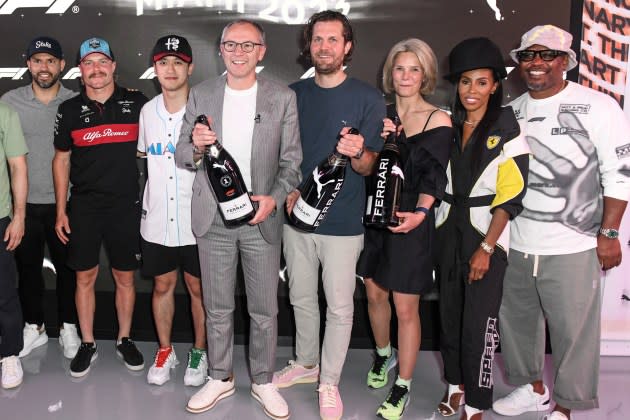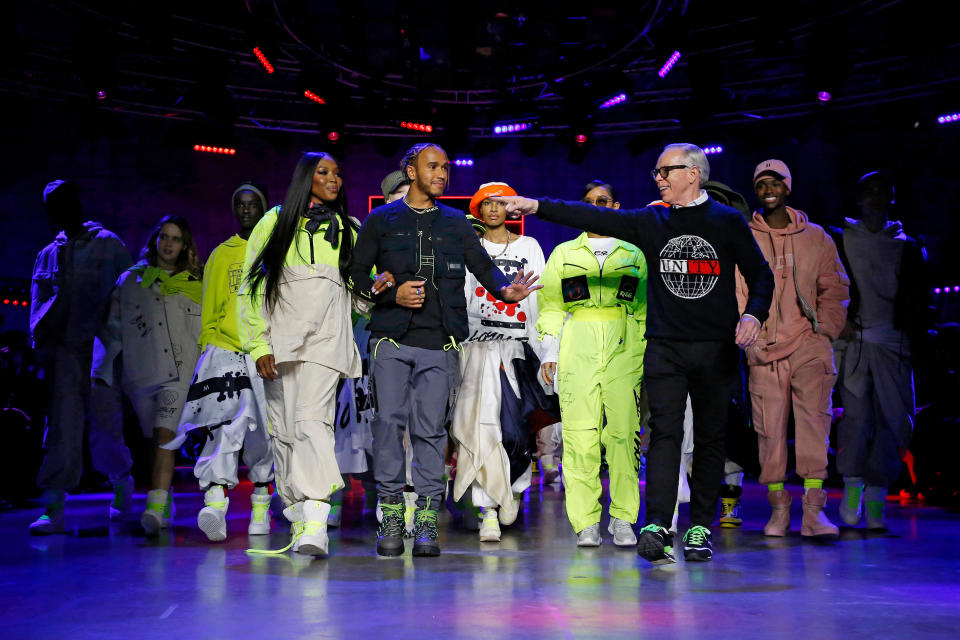Fashion Brands Are Tapping Into New Markets Through Sports Partnerships
- Oops!Something went wrong.Please try again later.
- Oops!Something went wrong.Please try again later.
- Oops!Something went wrong.Please try again later.
- Oops!Something went wrong.Please try again later.
- Oops!Something went wrong.Please try again later.
- Oops!Something went wrong.Please try again later.

As shown by the recent movie “Air,” athletes have always been a natural choice as brand ambassadorship for sportswear brands — sometimes even holding the power to revolutionize modern-day sports and culture.
Over the past few years, there has been an exponential rise in fashion and sports intertwining more than ever before. The NFL draft and NBA tunnel have become prime hot spots for all-star athletes such as Devin Booker, Stephen Curry, Kyle Kuzma, Joe Burrow, Shai Gilgeous-Alexander, Russell Wilson, Travis Kelce and Patrick Mahomes to showcase their personal style. Further evidence can be seen via the Instagram account @leaguefits, created by Slam Magazine and self-described as “where hoop and its lifestyle collide,” which has nearly 1 million followers.
More from WWD
Contemporary Cues: Parisian Party Girls, Jean Seberg and Art Deco Architecture
Emma Stone Buttons Up in Trenchcoat-inspired Dress by Louis Vuitton for New York Film Festival 2023
Formula 1 driver Lewis Hamilton has been the sole driving force in bringing high fashion to the racetrack; seen regularly entering the paddock wearing looks off-the-runway and custom outfits by both luxury heritage brands and emerging designers. Hamilton has been photographed wearing Louis Vuitton, Dior, Fendi, Wales Bonner, Martine Rose, Nanushka, Rick Owens and Ferragamo, among others.
Through Hamilton’s unique style, his impact on the fashion industry is widespread and has led to the creation of four collections with Tommy Hilfiger, a long-term sponsor of his team Mercedes AMG Petronas since 2018.
Hamilton’s trailblazing efforts have paved the way for the next generation of racers. Alfa Romeo’s Zhou Guanyu, Alpine’s Pierre Gasly and Scuderia Ferrari’s Charles Leclerc have all credited the British driver for allowing them to follow suit in the often buttoned-up sport. These racers, many of whom are based in Monaco, have quickly become front-row fixtures at Paris Fashion Week.

Unlike other drivers with their own fan merchandise, Scuderia AlphaTauri’s Daniel Riccardo created Enchanté, a brand that shies away from traditional Formula 1 apparel — with Kristen Bell guest starring in a campaign. Earlier this September, Williams Racing’s Alex Albon similarly has launched his own brand, Alex Albon Athletics. Ferrari further stepped into the market in 2021 by launching a luxury brand with creative direction by Rocco Iannone.
Formula 1 drivers, in particular, are having a massive surge in becoming brand ambassadors for fashion brands. McLaren’s Lando Norris recently starred in a brand campaign for luggage company Tumi — a fitting choice, as Formula 1 drivers notoriously travel throughout the year. Hugo Boss, PacSun, Lululemon, Giorgio Armani, Rolex, Tag Heuer, Richard Mille and Palm Angels are just some of the big names getting involved.
At the 2023 Miami Grand Prix, Puma — who counts fashion icon June Ambrose as creative director — and Formula 1 announced an exclusive partnership to become the sport’s official supplier and retain the right to create F1 branded apparel, footwear and accessories. With all eyes on the inaugural Vegas Grand Prix coming up in November (the third American race on the circuit), more upcoming brand activations are sure to come.
Starch Creative’s chief executive officer and founder, Brandon Ball, has worked with the likes of Adidas, Kith, Vans and Converse on 360-degree vertical integration, conceptualization and implementation of experiential retail design production.
Ball has worked extensively within the intersection of sports and brands and has witnessed firsthand the power of sports partnerships. He has previously worked on projects involving MLS, the Brooklyn Marathon, the PGA tour, the Premier League and more.
Here, Ball talks to WWD about his creative agency, how sports franchises can help fashion and retail brands expand their consumer reach, the increased visibility of sports through docu-dramas and more.
WWD: What are some of the major retail sports partnership projects your creative agency Starch Creative has worked on?
Brandon Ball: We have worked extensively with various sport-focused brands on a multitude of projects spanning sports such as skateboarding, basketball, soccer and golf.
Most notably, we have worked directly with MLS in tandem with their various partners. Our work in this space includes event activations and retail executions for 2023 Women’s World Cup, 2023 A Clubs Activations, 2023 A Clubs Photo shoots, 2022 FIFA World Cup/OMB Launch events, 2021 MLS jersey launch, 2021 MLS Pride Jersey Kits and beyond.
WWD: Why has there been an uptick of brands like Prada, Burberry, Adidas, Tag Heuer, Rolex and Puma getting involved with long-term partnerships with popular sports such as Formula 1, tennis, soccer and golf?
B.B.: The cultural impact of major sports events like the World Cup and Women’s World Cup, along with high-profile players like Messi joining MLS and captivating sports docu-dramas has significantly heightened the visibility of these leagues. The narratives have created a deeper emotional connection with audiences, making these sports more attractive for brands seeking authentic and engaging platforms to showcase their products. Now more than ever consumers are looking for authenticity and connection with the brands that they support. These types of things help brands to create that connection.
WWD: How does partnering with a major sports team or athlete help a brand expand its reach to new audiences?
B.B.: Partnering with a major sports team or athlete allows brands to tap into the passionate fan base of that league. This connection provides instant access to a large and diverse audience, often spanning across demographics, geographies and cultures. It enables brands to be part of conversations that matter to these fans, fostering brand loyalty and engagement while creating opportunities to introduce their offerings to new potential customers.
WWD: How important is it for a brand to align with the values and image of the sports team or athlete they are partnering with?
B.B.: Alignment with the values and image of the sports team or athlete is crucial. A successful partnership resonates when both entities share common goals and ethics. Consumers appreciate authenticity, and any separation between the brand’s message and the partnership can lead to consumer skepticism. A seamless match can amplify the brand’s credibility and emotional appeal, strengthening the overall impact of the partnership.
WWD: In your experience, what are some of the key factors that make a sports partnership campaign successful?
B.B.: There are quite a few key factors that take a sports campaign to the next level. These include:
Relevance and authenticity: The partnership must make sense and feel genuine to the brand, sport and audience. Consumers want to see campaigns that capture the essence of what it means to be a part of a fan base or a larger team goal. Each campaign needs to be customized to those unique experiences for every team.
Engaging content: Brands should create compelling content that goes beyond mere product placement and resonates with the sports audience. This can include audiovisuals, social media clips and thoughtful promotional events.
Innovation: Fans engage best with innovative and immersive experiences. This allows brands to enhance engagement and stand out among competitors while also giving fans a new way to connect with their teams.
Consistency: Maintain consistent messaging throughout all touchpoints of the campaign. This helps brands create a clear and strong brand story for fans to easily engage with.
Measurement: Define clear KPIs and tracking metrics to gauge the campaign’s impact. This will help your brand understand if you’re successful with your target audience and where there’s room for improvement.
WWD: How do you measure the ROI of a sports partnership marketing campaign?
B.B.: ROI is measured through a mix of quantitative and qualitative measures, and it’s all relative to each brand’s goals for their campaign. This could include increased sales, website traffic, social media engagement, brand sentiment analysis and audience reach. By analyzing these metrics against the initial investment, you can assess the effectiveness of the campaign and make informed decisions for the future.
WWD: What advice or tips can you give retailers and brands who want to explore getting involved with a sports partnership?
B.B.: Brands should do their research. Understand the sports culture, its audience and the values of the team or athlete before jumping in. This will help you ensure your brand’s values align with those of the sports entity to create a genuine connection — authenticity is key.
Storytelling is also an important part of a successful partnership. Craft a compelling narrative that seamlessly integrates your brand with the sports story. This can include timely athlete success stories, like Simone Biles’ comeback season, or wider team development, like HBO’s “Hard Knocks.”
Brands should be innovative in how they tell these stories, as well. Look for unique and creative ways to engage the audience beyond traditional avenues. Whether it be through an experiential event, a pop-up store or a TV series, fans are looking for new ways to connect with their favorite teams, and innovative ideas take that connection to a new level.
Finally, brands should always have a long-term vision or goal for their campaigns and consider building lasting partnerships for deeper impact and trust-building. This will also aid in authenticity for consumers, improving brand loyalty for the years ahead.
Best of WWD

